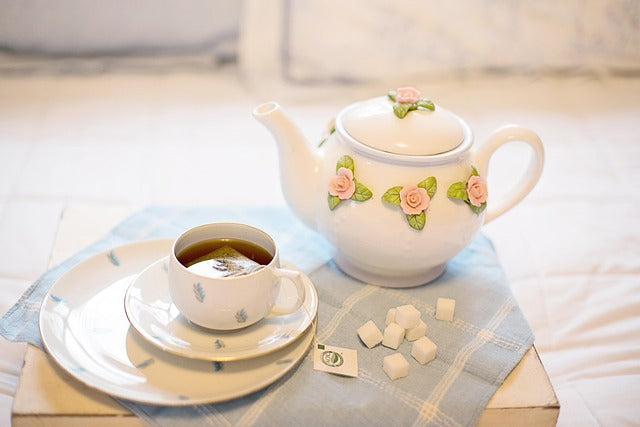Jasmine tea offers numerous health benefits and is known for its unique floral aroma and delicate flavor profile that appeals to many. Knowing how to make Jasmine tea is essential to fully enjoy its benefits. Let's delve into the process of making this delightful and healthy beverage.
Does Jasmine Tea Really Contain Jasmine?
Yes, Jasmine tea is made by blending green tea leaves with Jasmine petals. This caffeinated tea has a delicate floral aroma and can be found in various forms, such as thin, rolled tea leaves or small balls known as "Jasmine Pearls."
How Jasmine Tea Scented?
The traditional method of scenting Jasmine tea differs from modern practices. Traditionally, trays full of Jasmine flowers were placed under a woven tray of tea leaves. Nowadays, scenting is typically done by mixing tea leaves with Jasmine flowers and Jasmine extract. The most expensive, high-quality teas are scented using Jasmine flower buds, classifying them as premium teas. Jasmine extract is a more affordable option for lower-quality teas.
The Proper Way to Make Jasmine Tea
Jasmine green tea can be enjoyed on its own without the need for sugar, milk, or additional flavors. To prepare it correctly, using high-quality water is crucial, with filtered water being the recommended choice. For heating the water, an electric kettle with a temperature setting is ideal.
If you're brewing Jasmine pearl tea, a higher temperature than 175°F can be used. However, other types of Jasmine tea should be brewed at 175°F. Loose tea leaves are preferred for Jasmine tea, as tea bags can result in bitterness due to broken leaves.
How to Make Jasmine Tea
Choose your Jasmine Tea
There are two main types of Jasmine green tea to choose from based on your taste preferences: loose-leaf Jasmine tea and Jasmine Pearls. The flavor can vary depending on the tea type, with higher quality teas offering a refined taste similar to that of fine wine.
Prepare Your Water
Water is the foundation of any tea, including Jasmine tea. Spring water is the preferred choice for brewing, with filtered water as a secondary option. Distilled water is not recommended, as it does not allow the tea's flavors to fully develop.
Heat the Water
The ideal water temperature for making Jasmine tea is between 160-180°F. This temperature range helps preserve the tea's delicate flavor. Boiling water can compromise the quality of Jasmine leaf tea. To ensure the correct temperature, use a thermometer or an electric kettle with temperature settings.
Steep the Tea
The steeping time for Jasmine tea depends on the desired strength. Generally, Jasmine tea should be steeped for about 2 to 4 minutes. Tea experts recommend starting with a 2-minute steep and adjusting based on your taste preference.
Relax with Jasmine Tea
The flavor profile of Jasmine tea may really help with relaxing. It has the ability to awaken the senses with its sweet floral taste and fresh perfumed aroma. As the tea component also contains L-theanine, it helps to reduce anxiety and stress while allowing one to become calmer and more relaxed.
Does Jasmine Tea has Caffeine?
Most of the Jasmine tea types contain caffeine. The level of caffeine contained in each tea type highly depends on the tea that is used as the base for the blend. White tea contains the lowest caffeine level and Black tea contains the highest caffeine level. Green tea has a moderate amount of caffeine. The other factors that affect the caffeine level present in Jasmine tea include the number of tea leaves used for the tea, water temperature (high water temperature may bring more caffeine), and steep time.
Types of Jasmine Tea
There are Jasmine tea types based on the main components that are used to make the tea.
Jasmine Green Tea
Jasmine green tea is made from green tea and dried Jasmine flowers. It is rich in antioxidants and vitamin C, which can help boost energy levels.
Jasmine White Tea
This tea contains white tea and dried Jasmine flowers. Sometimes it includes a percentage of white tea and natural Jasmine flavors. It has a delicate, mildly sweet taste. Being the least processed tea type, white tea retains more nutrients and antioxidants.
Jasmine Black Tea
Jasmine black tea combines black tea with dried Jasmine flowers. The refreshing taste of black tea is enhanced with Jasmine flavor, making it a perfect afternoon drink. Due to its black tea base, Jasmine black tea contains more caffeine compared to other Jasmine tea types.
Jasmine Milk Tea
Jasmine milk tea includes milk and a sweetener along with the usual Jasmine tea ingredients. The milk can be a creamer or condensed milk. It can be served chilled or with ice cubes for an extra refreshing experience. This tea has a sweet and creamy flavor with a delicate floral undertone and is highly popular in restaurants and bubble tea shops. Jasmine milk tea is also considered a good option for promoting weight loss.
Tips to Remember
- Offers unique taste profiles with or without sugar and milk.
- Use high-quality water to preserve the best flavor.
- Loose tea is preferable to tea bags.
- Avoid using boiling water; use simmered water instead.
- Do not brew for an extended period to prevent bitterness.
- When making chilled Jasmine green tea; Add honey before adding ice and milk.
Conclusion
Jasmine tea, with its delightful floral aroma and numerous health benefits, is a versatile and enjoyable beverage. Whether you prefer the rich flavors of Jasmine green, white, black, or milk tea, understanding the proper preparation techniques ensures the best taste experience. By using high-quality ingredients and careful brewing methods, you can fully appreciate the unique characteristics of each type of Jasmine tea. So, take the time to prepare your Jasmine tea correctly and savor the delicate flavors and health benefits it has to offer.
